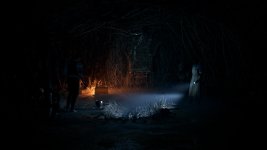General Information
Long before the Evil became Resident, the Hill fell Silent, and the Space turned Dead, there was another seminal survival horror classic that established a lot of the fright-heavy fundamentals that would stalk the shadowy hallways of the genre for decades to come. That game was 1992's Alone in the Dark, which featured 3D graphics that were groundbreaking at the time, as well as a genre-defining emphasis on puzzle-solving, inventory management, and combat that involved just as much flight as fight. Now developer Pieces Interactive has reimagined the aging original in the form of a new Alone in the Dark – but although it features some surprising environments to explore and a fairly compelling supernatural mystery to unravel, its shallow combat and basic enemy design ensures that it's not quite the triumphant haunted homecoming it could have been.
As was the case with the 1992 original, Alone in the Dark allows you to take control of either private investigator Edward Carnby or his client Emily Hartwood, an unlikely pair who travel together to a secluded estate in 1920s Louisiana called Derceto Manor in search of Emily's missing uncle, Jeremy. Whereas the original 3D models of Edward and Emily featured polygon counts so low it looked like they'd been assembled from a spilt bag of coloured tortilla chips, here they're played by David Harbour (Stranger Things) and Jodie Comer (Killing Eve), respectively. The two recognisable leads deliver credible performances amidst the incredible events that unfold around them, and Harbour in particular seems perfectly cast as a hardboiled detective who wouldn't balk at a glass of bourbon for breakfast.
Derceto Manor has been reimagined as a psychiatric hospital of sorts this time around, and there's an expanded cast of residents and members of staff to interact with over the course of the investigation, the bulk of whom are quirky, Southern Gothic types who seem as though they've stumbled right out of A Streetcar Named Desire. These interrogations grow increasingly unsettling as the missing-person mystery takes a twisted turn toward the paranormal, and it becomes harder to separate the actual setting from the abstract. What followed was an at times fanciful and often fascinating journey into darkness. I enjoyed piecing together Jeremy's fate via scraps of evidence collected throughout Derceto, as well as determining exactly what sort of dark magic was poisoning the roots of the Hartwood family tree.
Expanded cast and updated visuals aside, arguably the biggest departure Alone in the Dark takes from the original adventure is a literal one. The imposing Derceto Manor remains as a central hub for the events of the story and is packed with plenty of rooms to unlock and meticulously crafted adornments to examine. However, a new magic voodoo talisman allows Edward and Emily to temporarily venture beyond the boundaries of the estate into some surprising dream-like destinations, as they follow Jeremy's breadcrumb trail through a metaphysical maze made up of his memories. It doesn't ever match the uncanny, multimedia-morphing magic tricks of Alan Wake II, but it does make for some distinctly memorable story branches and welcome changes of pace. In one I found myself evading an unstoppable cosmic horror presence known as the 'Dark Man' amidst the heavily-stacked shelves of a vast, multi-level library, while in another I had to adjust reflected beams of light to open locked doors in a dusty Egyptian tomb like something straight out of an Indiana Jones adventure.
On that note, the puzzle design in Alone in the Dark is of a consistently stimulating standard. While you can opt for a simplified puzzle experience via the in-game options, I set the puzzle solution settings to 'old school' and reveled in occasionally getting completely stuck – or at the very least, slowing down for extended periods of time to pore over each detail in my surroundings or thumb through pages of collected notes in search of hidden clues. There's a nice variety too, from more visual brain teasers like arranging the fragments of an x-ray image into an unsettling whole, to the use of a codex to attribute numerical values to the sequence of symbols on a locked box.
Scareless Whisper
While I enjoyed Edward and Emily's journey through the hallways of Derceto Manor and the many unanticipated detours beyond its rot-infested walls, I was less enamored by the regular enemy encounters I was forced to overcome along the way. Outside of a couple of late game bosses, Alone in the Dark's cast of Lovecraftian creatures just aren't all that threatening, and the arsenal of firearms you're given to terminate them with is as bare-boned as a streaking skeleton. All you get your trigger-fingers on are a pistol, a shotgun, a machine gun, and – for one brief stretch towards the story's end – a flare gun. This modest combination perhaps remains true to the more simplified roots of survival horror, but it never really allows for much in the way of strategy beyond using the pistol for smaller foes like the annoying bats and spider creatures, and the beefier guns for anything bigger. In the notable absence of any form of inventory management you never need sweat about which weapon to prioritise either, and since there's no upgrade system or alternate ammunition types to try the gunplay feels just as rudimentary from the first shot fired to the last shell shucked.
There is admittedly a far greater number of melee weapons to pick up, from rusty lead pipes to ornate candelabras, but I never felt a tangible difference between them in terms of power or durability. They all seemed to have roughly the same impact whether they're blunt or bladed, and they all seem to break as quickly be it a wooden oar or a steel sledgehammer. I generally have no problem with breakable weapons, but my issue with Alone in the Dark is that you can only carry one melee weapon at a time – and once your fire poker snaps into splinters in the middle of an attack, the melee button ceases to function completely. I assume this is intended to induce a sudden sense of panic, but I've watched David Harbour throw a punch many times on screen before as Stranger Things' Sheriff Hopper, so it just seemed preposterous to see him regularly surrounded by enemy hordes and stubbornly unwilling to even summon up a belligerent shove while I mashed my melee attack to no avail.
You can also pick up and throw a couple of different projectile types, but neither are without their disappointing drawbacks. Bricks can be lobbed in order to distract an enemy away from their patrolling path, but you can't then creep up on them and take them out with an ammo-conserving stealth attack. Meanwhile molotov cocktails can be flung at monsters from afar, but they'll only occasionally explode on impact – for reasons I never fully understood, the shattered bottle's flammable contents would often just spill all over an enemy and I'd have to spend a precious round of ammo igniting their petrol-soaked skin with a bullet. In both cases, the act of picking up and carrying one of these throwable weapons forces you to hold down the trigger, locking you into a tightly zoomed-in aiming perspective and slowing your movement to a crawl until you release it, which felt particularly sluggish anytime I wanted to take a molotov for the road with me in case I needed it to help clear out the next room.
As for the enemies themselves, the small assortment of Alone in the Dark's shadowy demons look like they were based off smudged doodles stolen from Shinji Mikami's sketchbook; largely forgettable first drafts that lack the disturbingly detailed level of creative monster design found in the likes of the Resident Evil or The Last of Us series. With the exception of the multi-limbed final boss and its pulsating weak points, there's no distinct method for dispatching them either aside from just aiming for the head, and there isn't much in the way of shocking surprises like the tentacles that sprout out of the plague-riddled Spaniards' necks in Resident Evil 4, or corpses that come roaring back to life like the undead astronauts of Dead Space.
The general lack of surprise or threat from its horde of garden variety ghouls means that although the impressively gloomy lighting and chittering ambient audio does create a reasonably creepy atmosphere, Alone in the Dark never actually seems all that scary, which is a cardinal sin for a survival horror adventure. At no point did I feel genuinely intimidated by anything that emerged from the shadows, and since its basic brand of combat falls well short of the standards set by other survival horror classics released in recent years, rather than relish each enemy encounter I found myself wanting to quickly brush them aside so that I could get back to the more engaging puzzle-solving and plot development.
House of Retread
Speaking of the plot, I opted to play as Edward for my first playthrough of Alone in the Dark's story, which took roughly eight hours to complete. I then decided to play again as Emily, but was disappointed to discover that it was mostly the same experience. Dialogue cutscenes are slightly different, with Derceto staff and residents largely treating Emily with warmth and familiarity as opposed to the way they regard Edward as more of an outsider. Yet otherwise the vast majority of clues you uncover, puzzles you solve, environments you explore, enemies you encounter and where you find them are entirely unchanged, and both character paths culminate in the same final boss fight and astonishingly unhinged story conclusion.
Edward and Emily also share a near identical arsenal of weapons, with the one slight exception being that Emily's pistol can hold seven rounds per clip to Edward's six. Therefore playing as Emily means having to endure fractionally fewer pistol reloads, which has to be one of the most minor differentiations between playable characters since Ken and Ryu donned different coloured karate gi in the original Street Fighter.
Each character path does come with its own unique late game side story sequence, however. As Edward, I was able to relive the events of one of the investigations from his past, following a tangle of red strings that magically sprouted off an evidence board and twirled their way through the streets of New Orleans' French Quarter to striking effect. In doing so I was able to uncover a hidden connection that Edward shares with one of Derceto's residents, and enjoy a reasonably tense action sequence on a bridge that tasked me with fending off heaving masses of muscular tentacles trying to wrench the structure off its foundations.
However as Emily, this absorbing 30-minute sequence was swapped out for a stealth-based slog through winding, World War I-inspired trenches, suffering aggravating instant deaths at the claws of a seemingly invulnerable stalker enemy. Surprisingly, there were hardly any story scraps to collect along the way here, and almost every crate and container I opened throughout this plodding stretch was completely empty – as though I'd arrived at this bleak battlefield the day after they'd held the annual spring cleaning of the bunker.
Needless to say I found Edward's exclusive assignment to be the superior of the two by far, and minor additional story details notwithstanding, I felt like I would have been better off skipping the five extra hours I spent replaying Alone in the Dark as Emily in favour of just watching her protracted trench crawl on YouTube at 1.5x speed. For my money, Resident Evil 2's more robust twin scenario system did a much better job of making the playable plights of Leon and Claire feel equally essential, and I feel that perhaps Alone in the Dark would have been better if the developer had just combined Edward and Emily's story into a single alternating path like that of Saga and Alan in Alan Wake II.
Verdict
Like a Louisiana voodoo priestess, Alone in the Dark is not without its charms, but its basic combat lacks the flexibility and function of Resident Evil 4, its inventive narrative is never as mind-bending as Alan Wake II, its uninspired creature design can't compete with Dead Space, and it's not nearly as scary as any of them. Its central mystery intrigued me enough to lure me through its strand of imaginative settings all the way to its story's end as Edward, and its puzzle design did feel consistently rewarding, but I was disappointed to discover that there wasn't a substantial enough difference to make a repeat playthrough as Emily feel particularly worthwhile. While this remake is undoubtedly a step up from the three-decades-old original, Alone in the Dark fails to escape the shadows of the other contemporary survival horror titans that it helped spawn.






